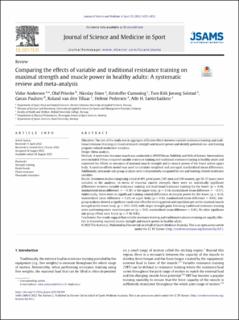| dc.contributor.author | Andersen, Vidar | |
| dc.contributor.author | Prieske, Olaf | |
| dc.contributor.author | Stien, Nicolay | |
| dc.contributor.author | Cumming, Kristoffer Toldnes | |
| dc.contributor.author | Solstad, Tom Erik Jorung | |
| dc.contributor.author | Paulsen, Gøran | |
| dc.contributor.author | van den Tillaar, Roland Johannes Wilhelmus | |
| dc.contributor.author | Pedersen, Helene | |
| dc.contributor.author | Sæterbakken, Atle Hole | |
| dc.date.accessioned | 2023-03-02T08:42:55Z | |
| dc.date.available | 2023-03-02T08:42:55Z | |
| dc.date.created | 2022-10-14T19:25:53Z | |
| dc.date.issued | 2022 | |
| dc.identifier.citation | Journal of Science and Medicine in Sport. 2022, 25(12), Side 1023-1032. | en_US |
| dc.identifier.issn | 1440-2440 | |
| dc.identifier.uri | https://hdl.handle.net/11250/3055183 | |
| dc.description | This is an open access article under the CC BY license (http://creativecommons.org/licenses/by/4.0/). | en_US |
| dc.description.abstract | Objectives: The aim of the study was to aggregate different effects between variable resistance training and traditional resistance training on maximal muscle strength and muscle power and identify potential sex- and training program-related moderator variables.
Design: Meta-analysis.
Methods: A systematic literature search was conducted in SPORTDiscus, PubMed, and Web of Science. Interventions were included if they compared variable resistance training and traditional resistance training in healthy adults and examined the effects on measures of maximal muscle strength and/or muscle power of the lower and/or upper body. A random-effects model was used to calculate weighted and averaged standardized mean differences. Additionally, univariate sub-group analyses were independently computed for sex and training-related moderator variables.
Results: Seventeen studies comprising a total of 491 participants (341 men and 150 women, age 18–37 years) were included in the analyses. In terms of maximal muscle strength, there were no statistically significant differences between variable resistance training and traditional resistance training for the lower (p = 0.46, standardized mean difference = −0.10) or the upper body (p = 0.14, standardized mean difference = −0.17). Additionally, there were no significant training-related differences in muscle power for the lower (p = 0.16, standardized mean difference = 0.21) or upper body (p = 0.81, standardized mean difference = 0.05). Sub-group analyses showed a significant moderator effect for training period and repetitions per set for maximal muscle strength in the lower body (p = 0.03–0.04) with larger strength gains following traditional resistance training when performing more repetitions per set (p = 0.02, standardized mean difference = 0.43). No other significant sub-group effects were found (p = 0.18–0.82).
Conclusions: Our results suggest that variable resistance training and traditional resistance training are equally effective in improving maximal muscle strength and muscle power in healthy adults. | en_US |
| dc.language.iso | eng | en_US |
| dc.subject | chain resistance | en_US |
| dc.subject | elastic bands | en_US |
| dc.subject | pneumatic resistance | en_US |
| dc.subject | strength training | en_US |
| dc.title | Comparing the effects of variable and traditional resistance training on maximal strength and muscle power in healthy adults: A systematic review and meta-analysis | en_US |
| dc.type | Peer reviewed | en_US |
| dc.type | Journal article | en_US |
| dc.description.version | publishedVersion | en_US |
| dc.rights.holder | © 2022 The Author(s) | en_US |
| dc.source.pagenumber | 1023-1032 | en_US |
| dc.source.volume | 25 | en_US |
| dc.source.journal | Journal of Science and Medicine in Sport | en_US |
| dc.source.issue | 12 | en_US |
| dc.identifier.doi | 10.1016/j.jsams.2022.08.009 | |
| dc.identifier.cristin | 2061571 | |
| dc.description.localcode | Institutt for fysisk prestasjonsevne / Department of Physical Performance | en_US |
| cristin.ispublished | true | |
| cristin.fulltext | original | |
| cristin.qualitycode | 1 | |
